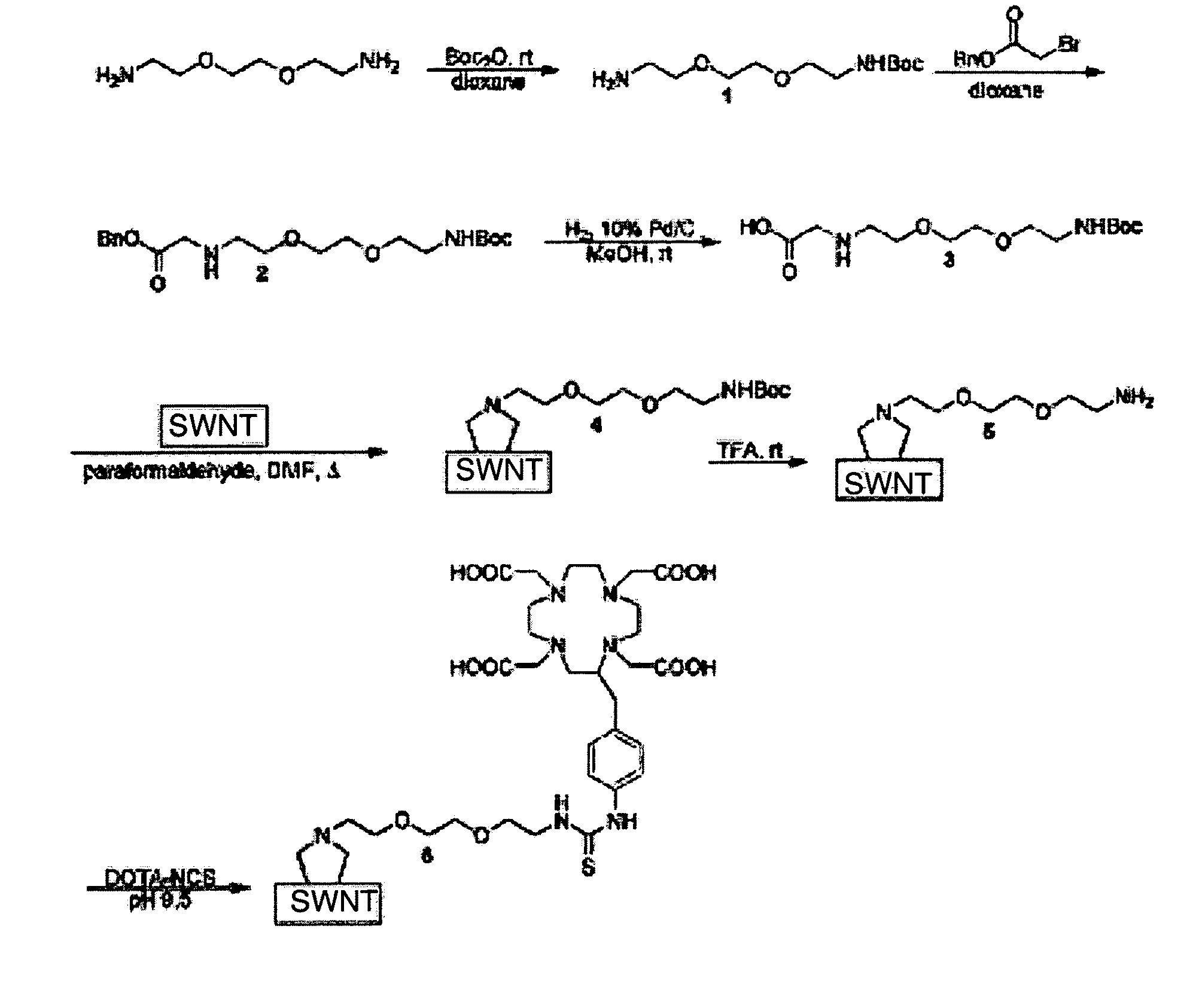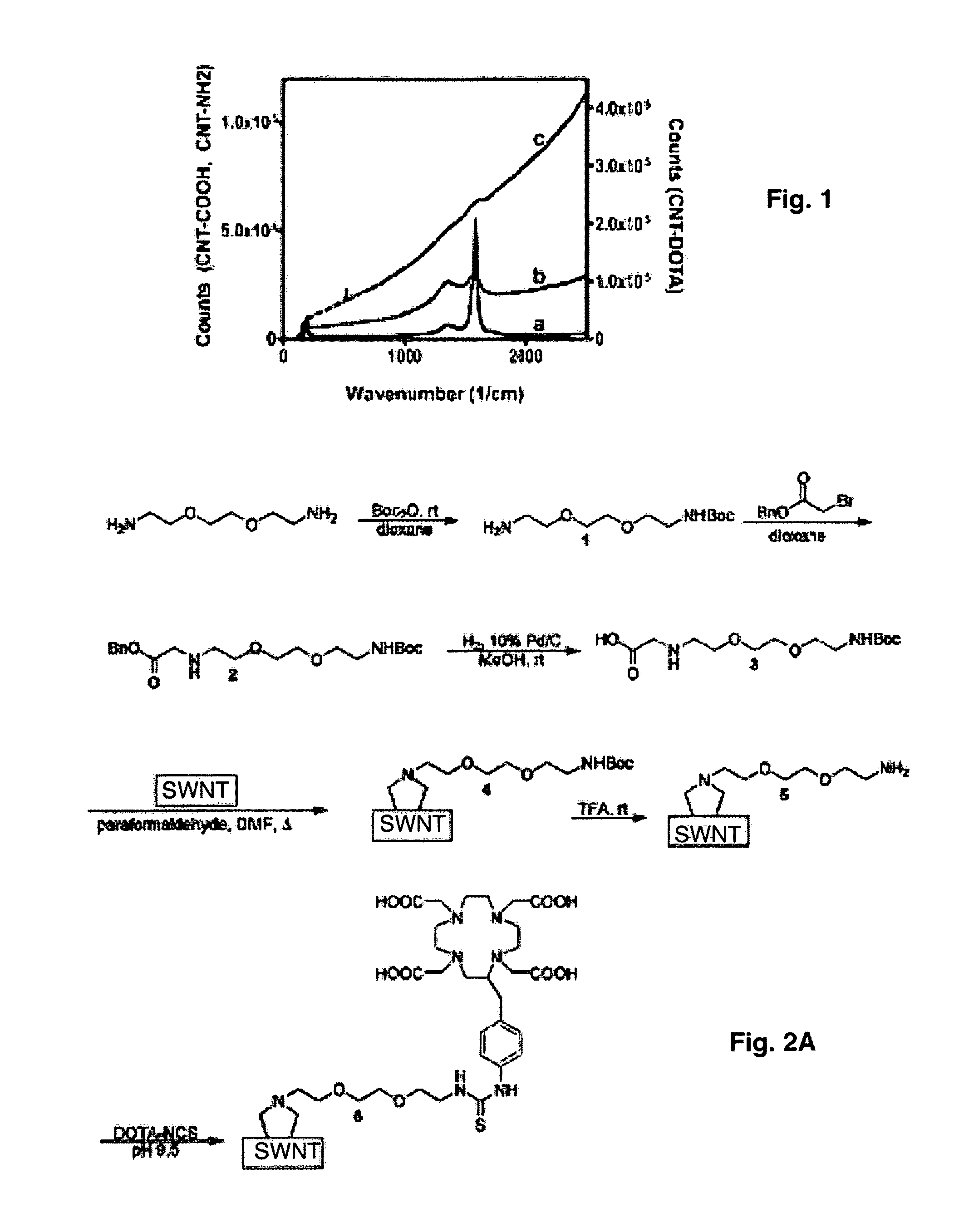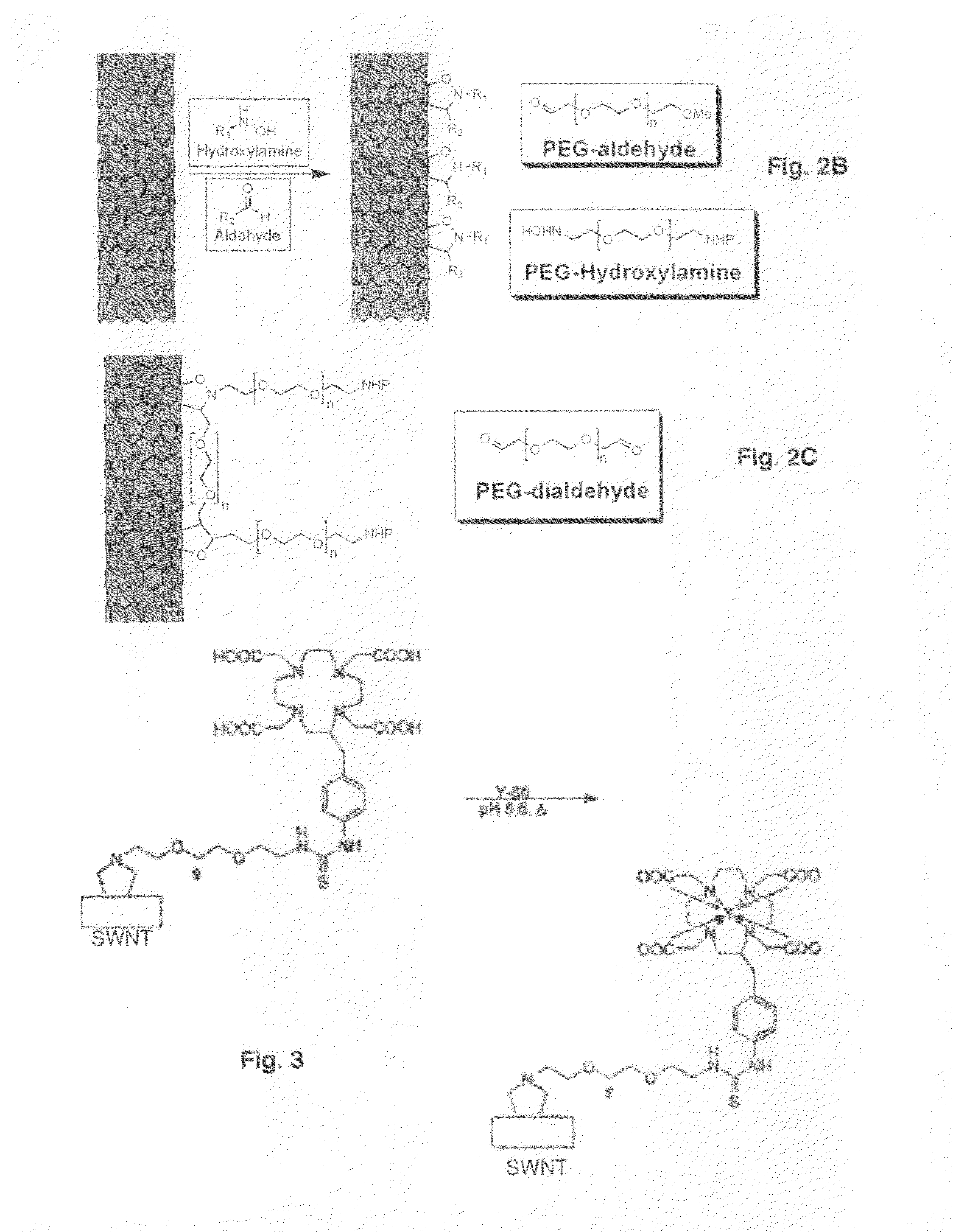Single wall nanotube constructs and uses therefor
a construct technology, applied in the field of functionalized single wall carbon nanotube therapeutic compositions, can solve the problems of nanotubes, unmodified, nanotubes, etc., and achieve the effect of reducing the number of nanotubes in the body
- Summary
- Abstract
- Description
- Claims
- Application Information
AI Technical Summary
Benefits of technology
Problems solved by technology
Method used
Image
Examples
example 1
Length Adjustment, Solubilization and Functionalization of SWNTs
[0067]Length Adjustment: Method I
[0068]Raw single walled carbon nanotubes (SWNT) about 1.4 nm in diameter were shortened to uniform length by oxidative acid digestion. Briefly, 60 mg of SWNT (Nanostructured & Amorphous Materials, Los Alamos, N. Mex.) were refluxed in concentrated 2M HNO3 (60 mL) for 48 hours. This digestion yields SWNT molecules with carboxy-functionalized termini. Shortening SWNT lengths to 250 nm and below requires sonication in addition to the refluxing. Sonication for 0.5 h was performed at 70° C. with 100 watts with a Biologics model 300 V / T Ultrasonic Homogenizer using the ⅜-in-diameter stepped titanium tip. The SWNT were then refluxed for an additional 10 h in the concentrated 2M HNO3. Acid reflux also removes residual metal catalyst from the tubes. It is generally believed that sonication-assisted shortening proceeds via the collapse of cavitation bubbles, generating local hot-spots, that create...
example 2
Derivatizing SWNT-DOTA-Mal with Antibodies and Fragments, DNA or PNA
[0091]Rituximab or Lintuximab (HuM195)
[0092]Controlled introduction of free sulfhydryl (—SH) groups into an antibody, e.g., rituximab (Genentech, Inc.) or lintuximab (HuM195; Protein Design laboratories), is accomplished by reaction of the antibody with 2-iminothiolane-HCl (Traut's reagent). Briefly the protein was dissolved in PBS containing 5 mM EDTA buffer. Depending on the level of thiolation desired, a 2 to 20 molar excess, preferably a 10 molar excess, of Traut's reagent was added. Briefly, a 10-fold molar excess of Traut's reagent (Pierce Biotechnology, Inc.) was added to 2 mg of antibody in 0.25 ml PBS / 5 mM EDTA buffer and the pH was increased to 8-9 with 1M bicarbonate buffer. The reaction proceeds for 1 hour at ambient temperature. The thiolated antibody is purified from the excess Traut's reagent by a 10DG size exclusion column (Bio-Rad). The number of reactive thiol groups that were appended onto the ant...
example 3
Derivatizing Functionalized SWNTs with Bifunctional Chelate Radiometals, Trace Labels and Markers: SWNT-86Y*DOTA Constructs
[0101]86Y was produced in the Memorial Sloan-Kettering Cancer Center cyclotron core facility via the (p,n) nuclear reaction (15-16) on an enriched strontium-86 target. 10.5 mCi of reactive 86Y in 0.05 M HCl was provided for labeling. Activity was assayed in a Squibb CRC-15R Radioisotope Calibrator (or equivalent model) (E.R. Squibb and Sons, Inc., Princeton, N.J.) set at 711 and dividing the displayed activity value by 2.
[0102]The 86Y-SWNT construct (7) was prepared by adding 8 mCi (206 Mbq) of acidic 86Y to 0.150 mg of SWNT-DOTA (10 mg / mL) in MFW and 0.050 mL of 3M ammonium acetate (Aldrich) to yield a pH 5.5 solution. The reaction mixture was heated to 60° C. for 30 min. and then purified by size exclusion chromatography using a P6 resin (BioRad) as the stationary phase and 1% human serum albumin (HSA, Swiss Red Cross, Bern, Switzerland) and 0.9% NaCl (Abbott ...
PUM
| Property | Measurement | Unit |
|---|---|---|
| Solubility (mass) | aaaaa | aaaaa |
| Therapeutic | aaaaa | aaaaa |
| Immunogenicity | aaaaa | aaaaa |
Abstract
Description
Claims
Application Information
 Login to View More
Login to View More - R&D
- Intellectual Property
- Life Sciences
- Materials
- Tech Scout
- Unparalleled Data Quality
- Higher Quality Content
- 60% Fewer Hallucinations
Browse by: Latest US Patents, China's latest patents, Technical Efficacy Thesaurus, Application Domain, Technology Topic, Popular Technical Reports.
© 2025 PatSnap. All rights reserved.Legal|Privacy policy|Modern Slavery Act Transparency Statement|Sitemap|About US| Contact US: help@patsnap.com



